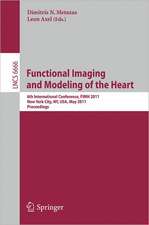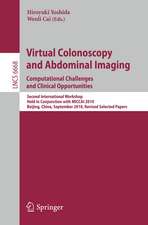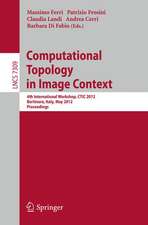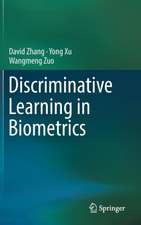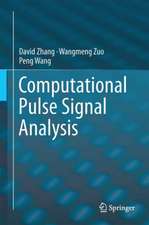Human Centric Visual Analysis with Deep Learning
Autor Liang Lin, Dongyu Zhang, Ping Luo, Wangmeng Zuoen Limba Engleză Hardback – 27 noi 2019
Specifically, this book addresses four important research topics, including 1) localizing persons in images, such as face and pedestrian detection; 2) parsing persons in details, such as human pose and clothing parsing, 3) identifying and verifying persons, such as face and human identification, and 4) high-level human centric tasks, such as person attributes and human activity understanding. This book can serve as reading material and reference text for academic professors / students or industrial engineers working in the field of vision surveillance, biometrics, and human-computer interaction, where human centric visual analysis are indispensable in analysing human identity, pose, attributes, and behaviours for further understanding.
Preț: 930.07 lei
Preț vechi: 1162.59 lei
-20% Nou
Puncte Express: 1395
Preț estimativ în valută:
177.99€ • 193.27$ • 149.51£
177.99€ • 193.27$ • 149.51£
Carte tipărită la comandă
Livrare economică 23 aprilie-07 mai
Preluare comenzi: 021 569.72.76
Specificații
ISBN-13: 9789811323867
ISBN-10: 9811323860
Pagini: 160
Ilustrații: XII, 156 p. 53 illus., 46 illus. in color.
Dimensiuni: 155 x 235 mm
Greutate: 0.42 kg
Ediția:1st ed. 2020
Editura: Springer Nature Singapore
Colecția Springer
Locul publicării:Singapore, Singapore
ISBN-10: 9811323860
Pagini: 160
Ilustrații: XII, 156 p. 53 illus., 46 illus. in color.
Dimensiuni: 155 x 235 mm
Greutate: 0.42 kg
Ediția:1st ed. 2020
Editura: Springer Nature Singapore
Colecția Springer
Locul publicării:Singapore, Singapore
Cuprins
Part I Motivation & Overview.- Chapter 1: The Foundation and Advances of Deep Learning.- Chapter 2. Human Centric Visual Analysis: Tasks and Progress.- Part II Localizing Persons in Images.- Chapter 3: Face Localization and Enhancement.- Chapter 4: Pedestrian Detection with RPN and Boosted Forests.- Part III Parsing Person In Details.- Chapter 5: Self-supervised Structure-sensitive Learning for Human Parsing.- Chapter 6: Instance-level Human Parsing.- Chapter 7: Video Instance-level Human Parsing.- Part IV Identifying and Verifying Persons.- Chapter 8: Person Verification.- Chapter 9: Face Verification.- Part V Higher Level Tasks.- Chapter 10: Human Activity Understanding.
Notă biografică
Liang Lin is a Full Professor at Sun Yat-sen University, and the CEO of DMAI Great China. He served as the Executive Director of the SenseTime Group from 2016 to 2018, leading the R&D teams in developing cutting-edge, deliverable solutions in computer vision, data analysis and mining, and intelligent robotic systems. He has authored or co-authored more than 200 papers in leading academic journals and conferences (e.g., TPAMI/IJCV, CVPR/ICCV/NIPS/ICML/AAAI). He is an associate editor of IEEE Trans, Human-Machine Systems and IET Computer Vision, and he served as the area/session chair for numerous conferences, such as CVPR, ICME, ICCV, ICMR. He was the recipient of Annual Best Paper Award by Pattern Recognition (Elsevier) in 2018, Dimond Award for best paper in IEEE ICME in 2017, ACM NPARBest Paper Runners-Up Award in 2010, Google Faculty Award in 2012, award for the best student paper in IEEE ICME in 2014, and Hong Kong Scholars Award in 2014. He is a Fellow of IET.Dongyu Zhang is a Research Scientist at the School of Data and Computer Science, Sun Yat-sen University (SYSU), China. He received his Master’s and Ph.D. degree in Computer Science from the Harbin Institute of Technology (HIT), China, in 2003 and 2008, respectively. His current research interests include deep learning, image modeling and biometrics.
Ping Luo is a Research Assistant Professor at the Chinese University of Hong Kong, where he received his Ph.D. degree in 2014. His research interests focus on machine learning and computer vision, including deep learning optimization and theory, face and pedestrian analysis, image parsing, and large-scale object recognition and detection. Dr. Luo has published more than 60 papers in the top-tier academic journals and conferences,including TPAMI, IJCV, NIPS, ICML, and CVPR. His papers have over 6000 citations in Google Scholar. Because of his contribution in deep learning and computer vision, Dr. Luo was awarded the Microsoft Research Fellowship in 2013. Only ten scholars in the Asia-Pacific area received this award each year. Besides, he was elected the Hong Kong PhD Fellowship in 2011 by the Research Grants Council of Hong Kong.
Wangmeng Zuo is a Professor at the School of Computer Science and Technology, Harbin Institute of Technology (HIT), China. He received his Ph.D. degree in Computer Application Technology from the HIT in 2007. From July 2004 to December 2004, from November 2005 to August 2006, and from July 2007 to February 2008, he was a Research Assistant at the Department of Computing, Hong Kong Polytechnic University. From August 2009 to February 2010, he was a Visiting Professor at Microsoft Research Asia. His current research interests include image restoration, image editing, image classification, object detection, and visual tracking. Dr. Zuo is an Associate Editor of the IET Biometrics, and a Guest Editor of Neurocomputing, Pattern Recognition, and IEEE Transactions on Neural Network and Learning Systems.
Ping Luo is a Research Assistant Professor at the Chinese University of Hong Kong, where he received his Ph.D. degree in 2014. His research interests focus on machine learning and computer vision, including deep learning optimization and theory, face and pedestrian analysis, image parsing, and large-scale object recognition and detection. Dr. Luo has published more than 60 papers in the top-tier academic journals and conferences,including TPAMI, IJCV, NIPS, ICML, and CVPR. His papers have over 6000 citations in Google Scholar. Because of his contribution in deep learning and computer vision, Dr. Luo was awarded the Microsoft Research Fellowship in 2013. Only ten scholars in the Asia-Pacific area received this award each year. Besides, he was elected the Hong Kong PhD Fellowship in 2011 by the Research Grants Council of Hong Kong.
Wangmeng Zuo is a Professor at the School of Computer Science and Technology, Harbin Institute of Technology (HIT), China. He received his Ph.D. degree in Computer Application Technology from the HIT in 2007. From July 2004 to December 2004, from November 2005 to August 2006, and from July 2007 to February 2008, he was a Research Assistant at the Department of Computing, Hong Kong Polytechnic University. From August 2009 to February 2010, he was a Visiting Professor at Microsoft Research Asia. His current research interests include image restoration, image editing, image classification, object detection, and visual tracking. Dr. Zuo is an Associate Editor of the IET Biometrics, and a Guest Editor of Neurocomputing, Pattern Recognition, and IEEE Transactions on Neural Network and Learning Systems.
Textul de pe ultima copertă
This book introduces the applications of deep learning in various human centric visual analysis tasks, including classical ones like face detection and alignment and some newly rising tasks like fashion clothing parsing. Starting from an overview of current research in human centric visual analysis, the book then presents a tutorial of basic concepts and techniques of deep learning. In addition, the book systematically investigates the main human centric analysis tasks of different levels, ranging from detection and segmentation to parsing and higher-level understanding. At last, it presents the state-of-the-art solutions based on deep learning for every task, as well as providing sufficient references and extensive discussions.
Specifically, this book addresses four important research topics, including 1) localizing persons in images, such as face and pedestrian detection; 2) parsing persons in details, such as human pose and clothing parsing, 3) identifying and verifyingpersons, such as face and human identification, and 4) high-level human centric tasks, such as person attributes and human activity understanding.
This book can serve as reading material and reference text for academic professors / students or industrial engineers working in the field of vision surveillance, biometrics, and human-computer interaction, where human centric visual analysis are indispensable in analysing human identity, pose, attributes, and behaviours for further understanding.
Specifically, this book addresses four important research topics, including 1) localizing persons in images, such as face and pedestrian detection; 2) parsing persons in details, such as human pose and clothing parsing, 3) identifying and verifyingpersons, such as face and human identification, and 4) high-level human centric tasks, such as person attributes and human activity understanding.
This book can serve as reading material and reference text for academic professors / students or industrial engineers working in the field of vision surveillance, biometrics, and human-computer interaction, where human centric visual analysis are indispensable in analysing human identity, pose, attributes, and behaviours for further understanding.
Caracteristici
Presents effective deep learning based solutions for human centric visual analysis Summarizes the latest studies in human centric visual analysis Covers many practical examples and applications for human centric visual analysis















